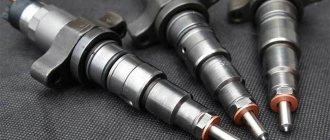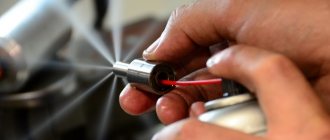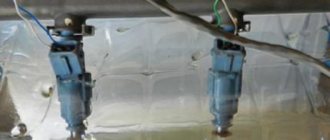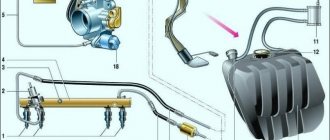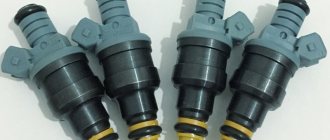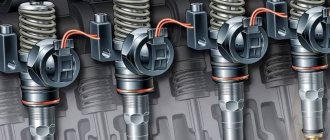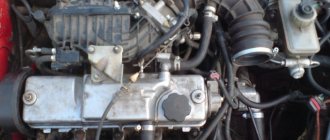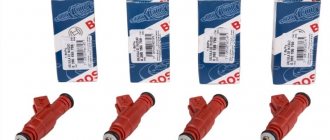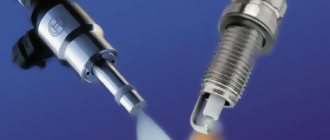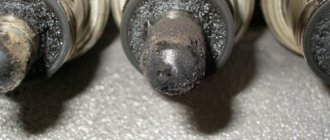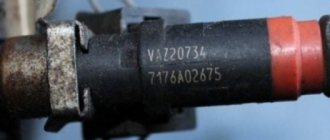Signs of a faulty diesel engine injector
Most often, a malfunction of diesel injectors is detected very quickly by the driver. But if the owner of a diesel car has no experience of owning such a car, then he may not immediately recognize the breakdown. The first thing you should pay attention to is the operation of the engine. At the first stages, no signs of breakdown appear. On the contrary, the car starts to drive a little better than usual. Yes, I didn’t make a mistake now. Everything is exactly like that. The fact is that due to faulty injectors, more fuel than required may enter the combustion chamber. Because of the rich mixture, the car starts to drive better.
If you miss this moment, then a smooth ride will gradually develop into a larger breakdown. After some time, you will begin to notice that the car began to smoke when starting, and the idle speed became unstable, and the speed began to fluctuate.
At the most advanced stages, fuel consumption increases significantly, and the car begins to smoke even when driving or sharply pressing the gas pedal. Gradually, as the injector pours fuel, it will begin to flow through the rings into the oil. This may cause the engine oil level to increase and its properties to deteriorate. And this can already lead to serious repairs.
Checking injectors at home with an ear and a screwdriver!
- We start the engine and let it warm up.
- Then take the largest long screwdriver and place it in the base of the fuel injector.
- Be careful! When checking the injectors using this method, your clothes, hair, etc. should not hang over the moving parts!
- We put our ear to the handle of the screwdriver and listen carefully to the sound.
If, when listening to the fuel injector, you hear a continuous series of clicks that are uniform and not very loud, then you can assume that the injector is working properly and is working as it should.
If the clicks are intermittent, irregular and with pauses, most likely the injector is stuck or jammed and requires flushing or even replacement. At a minimum, such an injector should be removed for further diagnostics.
We carry out the described procedure for each injector, after which we decide whether there is any point in visiting a service station or not. This method does not provide 100% confidence, but a preliminary conclusion can be made. Moreover, it is free and available to everyone. If there are errors indicating problems with the injectors, then this method will, at a minimum, help verify that there really is a problem.
After such a diagnosis, you can try to restore the operation of the injector using flushing fluid, or you can stop by the station and carry out a full cleaning of the injectors on an ultrasonic stand.
Why do injectors on a diesel engine fail?
The injectors on a diesel engine come out faster than on a gasoline engine. This is due to the fact that these motors have different operating principles. But in both cases, the culprit is low-quality fuel or untimely replacement of the fuel filter. If you service the car on time, the injectors should work for at least 150,000 km without replacement or repair. If you also use high-quality fuel, then the factory injectors should last 200-300 thousand km.
But, as a rule, the fuel used is not of the highest quality, and filters are rarely changed. Therefore, the injectors in modern diesel engines hardly last 150 thousand km. Then they become dirty and begin to dose fuel incorrectly. To fix this, you will have to at least mechanically clean them of deposits and dirt. It is better not to put this procedure on the back burner, but to entrust the work to people who understand this.
Therefore, fill in high-quality fuel and do maintenance on time. High-quality, timely car maintenance will help you avoid unpleasant breakdowns in the future.
Why an engine injector leaks: causes and repairs
Issues discussed in the material:
- What is the purpose of a fuel injector?
- Why might an injector leak on a gasoline or diesel engine?
- How to determine if an engine injector is faulty
- Is it possible to repair an injector if it is leaking?
The fuel injector is the main component of the power supply system of a gasoline or diesel engine. Its main task is to provide direct fuel supply to the intake air tract chamber or directly to the engine cylinders by spraying. The fuel injector can become a source of problems if it leaks fuel. We will tell you why the injector is leaking and how to fix this problem in our article.
Operating principle of a diesel engine injector
Let us describe the design of the part using the example of a primitive mechanical injector with 1 spring. In the side part there is a channel that provides a continuous supply of diesel fuel. Inside the nozzle chamber there is a movable barrier with a spring and a needle, which lowers as pressure increases. The needle rises, clearing the path of fuel to the atomizer.
Additionally, more advanced types of nozzles can be noted:
- Piezoelectric: the spring pusher is lowered under the influence of a piezoelectric element. This technology ensures high intensity of opening of the nozzle: fuel savings are achieved, while the internal combustion engine operates more smoothly.
- Electrohydraulic: the design includes inlet and drain throttles, as well as an electromechanical valve. The operating mode of the components is regulated by the engine control unit.
- Pump injectors: used in engines that do not have a high pressure fuel pump. Fuel is supplied directly to the injectors. Inside such spray devices there is its own plunger pair, which generates the pressure necessary for injection.
Due to excessive loads, the injector may fail due to a violation of the engine operating mode. Manufacturers claim a parts life of up to 200,000 km, but due to negative operational factors, wear of parts appears much earlier.
How to clean an injector
Of all injector failures, 60% of malfunctions occur due to its clogging - it begins to pour into the cylinder. To combat such a common problem, we have come up with several ways to clean injectors.
We list those that can be implemented in a garage:
- Cleaning injection elements using an ultrasonic unit (ultrasonic washing) . This method, based on the cavitation effect, is quite labor-intensive and requires special equipment. An ultrasonic bath is used in which the nozzles pouring into the cylinder are washed repeatedly. This cleaning results in good atomization.
- Flushing the injector without removing it . It is produced using cleaning additives that are added to the fuel tank. This additive normalizes the operation of the entire engine, including the injection elements that are poured into the cylinder. There is a very large selection of such cleaning products on sale today.
Which of these methods is better? There is still disagreement on this matter. Objectively, it can be noted that ultrasonic washing is most often used for serious problems with the engine (for example, its unclear operation). Flushing injectors with additives, on the contrary, is more effective as part of preventative engine cleaning. In this case, it copes well with carbon deposits that form on the valves. However, the contaminated injector that pours into the cylinder is cleaned superficially using this method. Additives may not be able to eliminate deeper stages of clogging. Moreover, cleaning is done blindly: it will not be possible to target the problem area. Therefore, when it is necessary to check in detail and determine the throughput of sensors, they mainly resort to ultrasonic treatment. It is produced in specialized car services that have the appropriate software for calculations.
Of course, a better cleaning method in an ultrasonic bath will cost 2-3 times more than simple liquid treatment. But here lies another danger. Worn and faulty injectors pouring into the cylinders can be completely damaged by cavitation, as a result of which these elements lose their tightness.
Causes of injector malfunction
Repair of diesel injectors may be required for the following reasons:
- Low quality diesel fuel: the scourge of all diesel drivers. Due to impurities in the fuel, the atomizer becomes clogged; the dosage and fuel supply mode are violated.
- Poor assembly quality of the injection component or manufacturing defect: the injector does not withstand operating conditions, the part as a whole or individual components fails.
- Mechanical damage caused by incorrect operation of adjacent internal combustion engine systems.
Usually the breakdowns are of the following nature: the spray angle and the amount of fuel supplied changes, the integrity of the housing is compromised, and the needle stroke worsens.
Why is the injector leaking?
Why does the nozzle on an injection machine leak? Because the o-rings have deteriorated. Let's talk about this in more detail.
Rubber O-rings are used to eliminate air leaks and fuel leakage at the point where the injector is connected to the fuel line, in other words, for sealing. They can have an x-shaped, round or rectangular cross-section. They can be elastic, rigid, resistant to temperature changes, the negative effects of aggressive environments and various chemicals.
We recommend
1. Seals on different types of injectors.
Self-ignition of the working mixture occurs due to the high degree of compression; the load on the cylinder-piston group is high. A common mechanical pump injector is screwed into the cylinder head; to ensure a tight seal, a soft metal washer is used, installed on the bottom of the landing well. Copper is most often used, less often aluminum alloys. The metal must be soft and deform when tightened to ensure a tight seal.
Injection is carried out through a mechanical drive from the camshaft through pushers with rocker arms. Fuel is supplied through a metal pipeline; the return drain line is sealed with copper washers on the fittings.
Modern interpretations of this part are controlled electronically, which makes it necessary to significantly increase the fuel inlet pressure. This led to the need to use additional seals.
Inlet or upper o-rings are found on both gasoline and diesel injectors. They serve to eliminate air leaks and fuel leakage at the point where the injector is connected to the fuel line. They are most often made of rubber, since there are no large mechanical and temperature effects. However, the requirements for the material of the rings are high in terms of elasticity and its preservation under the influence of aggressive environmental factors.
The lower seal operates under more severe conditions, so the following options are possible:
- one metal ring;
- one rubber, made of a special composition, capable of withstanding temperature and mechanical stress;
- metallic and elastic at the same time;
- no one.
2. Symptoms of faulty o-rings.
It is often quite difficult to determine what caused the damage and failure of the o-ring - errors in design, improper installation or non-compliance with operating conditions. Sometimes a malfunction can be caused by several factors acting simultaneously. As a rule, damage to the upper seal is detected by fuel leaks. It could just be a wet spot, drops or even a trickle. Leakage of fuel here is very dangerous due to the possibility of it flowing down onto the hot output manifold, which definitely leads to a fire; urgent replacement is required.
If the lower seal is faulty, air leaks in and the mixture becomes lean. The engine starts only when the gas pedal is partially pressed, idles unstably, and power decreases, especially at low speeds.
With high mileage, the rings, especially the lower ones, due to high temperatures, can simply become stiff and lose elasticity. Then the smell of gasoline appears in the cabin at low temperatures when starting. The replacement may wait a little, but you shouldn’t delay it for too long.
On some diesel engines, leaks in the lower o-rings lead to gases breaking through and entering the oil. Coke is formed, which is washed into the oil pan and clogs the oil receiver. The main symptom in this case is white acrid smoke within a few seconds after starting, and when the malfunction occurs, the oil pressure lamp blinks. This car cannot be used; faulty parts need to be replaced.
We recommend
3. When to change the seals on the injectors.
Checking the functionality of the injector
There are several methods for checking the functionality of the sprayer. The easiest way to check the injector is with the engine running:
- Start the engine at idle speed.
- Start unscrewing the nozzles one by one.
- If after removal the engine performance deteriorates, then the removed injector is operational and should be returned to its place.
- By process of elimination you will find an injector, the removal of which will not change the operating mode of the internal combustion engine. This will be a broken device.
You can use a multimeter for diagnostics. In advance, you need to disconnect the battery terminals and disconnect the injector wiring, and then “check” each part with the device. On high resistance injectors, the device values will be in the range of 11 - 17 ohms; at low impedance the multimeter will show up to 5 ohms.
Tip: Having a maximeter will be a big advantage. The device is able to show the current pressure at which the sprayer is activated. It will also help identify defects regarding the spray angle and injection jet configuration.
How to check the power supply to the injectors
This check is carried out if the injectors themselves are working, but any of the injectors do not work when the ignition is turned on.
- for diagnostics, the connector is disconnected from the injector, after which two wires need to be connected to the battery;
- the other ends of the wires are attached to the injector contacts;
- then you need to turn on the ignition and record the presence or absence of fuel leakage;
- if fuel flows, then this sign indicates problems in the electrical circuit;
Troubleshooting
A faulty injector must be inspected. First, we look for leaks in the part body. If there are none, we proceed to disassembling the part. We fasten the part in a vice and knock out the spray nozzle by gently tapping it. Next, you need thorough cleaning: soak the parts of the nozzle in diesel fuel or solvent to remove carbon deposits. We remove soot and deposits with a fine steel grater. After cleaning is completed, you need to check the nozzle on the maximeter. If optimal injection parameters are achieved, the device is ready for installation in the engine.
In other cases, it is necessary to completely replace the nozzle on the defective nozzle. When installing a new part, carefully remove all factory grease, otherwise the device will not work.
If the nozzle continues to “flow” even after replacing the nozzle and thorough cleaning, pay attention to the performance of the spring with the pin - they may be worn out.
To clean the sprayer, use a compressor - the air pressure will knock out hard-to-reach dirt.
How to wash injector nozzles with your own hands
-channel “Mikhail Nesterov”
There is a solenoid needle valve located inside the fuel injector body. It is held closed by a return spring. When pulses are supplied from the electronic control unit (ECU) to the excitation winding, the valve opens. At this moment, the fuel is atomized and mixed with air, burned in the combustion chamber.
The correct proportions of the air-fuel mixture and its ignition depend on the quality of gasoline atomization. During normal operation of the injectors, the fuel is crushed into small particles, easily mixed with air and burned.
Why do injectors clog?
Impurities in the fuel, short trips and difficult operating conditions lead to carbon deposits forming on the needle and internal surfaces of the injector. This plaque clogs the channels. The solenoid valve opens for a long time and more gasoline enters the combustion chamber than necessary.
-channel "Auto-topic"
All this leads to an over-enrichment of the fuel mixture, poor ignition and misfires. Unburnt gasoline enters the exhaust system and burns out inside the catalyst, which becomes clogged and melts at high temperatures. At the same time, engine power decreases, detonation appears, and fuel consumption and exhaust toxicity increase.
How to understand that you need to flush the injectors
Car manufacturers recommend cleaning every 30 thousand kilometers. Problems with the injectors will be indicated by corresponding errors on the on-board computer. The same thing will be shown by diagnostics of fuel equipment in a car service center.
But with a high probability, flushing is needed regardless of mileage, if at least three symptoms from the list appear in your car:
- poor starting (especially in winter);
- unstable operation at idle speed;
- reduction in engine power;
- slow acceleration;
- dips when pressing the gas pedal;
- increased fuel consumption.
Method 1: fuel additive
Typical bottle of fuel additive for flushing / drive2.ru
The simplest and relatively gentle cleaning method is using special additives. More suitable for preventing the formation of deposits inside all elements of the fuel system - from the gas tank to the injectors.
The disadvantage of such additives is that on cars with high mileage they lift all the dirt from the gas tank and pipelines. As a result, the filters and the injectors themselves become clogged, which leads to even more disastrous consequences.
You will need
- Fuel additive-injector cleaner.
How to do
- Pour the product into the tank immediately before refueling according to the proportions in the attached instructions.
- Operate the vehicle as normal.
- For the best cleaning effect, it is advisable not to stand in city traffic jams, but to drive along the highway.
Method 2: flushing the injectors on the engine
This cleaning method is more difficult, but also more effective. It not only cleans the injectors, but also additionally decarbonizes the piston rings and also increases compression. Flushing is carried out with the engine running, which runs on detergent instead of gasoline.
The main disadvantage is that the quality of washing cannot be controlled. Other disadvantages include the entry of aggressive substances into the exhaust tract and potential damage to the catalyst. After using some products, spark plugs may need to be replaced.
Nozzle installation
Before dismantling the device, mark all parts with a marker to avoid confusion. Be especially careful about marking high-pressure hoses. The nozzle is screwed in by hand as far as you can. Further tightening is performed with a dynamometer wrench. The tightening values are indicated in the motor manual. When installing the injector, bleed the air from the fuel system. On modern cars, this is enough to turn the starter several times; or use a manual pump (if available).
Fuel injector - what is it?
The injector is an important mechanism of the fuel system and is intended for timely and dosed supply of fuel into the combustion chamber of the internal combustion engine.
It is a mechanical fuel sprayer into the engine cylinders. Its main feature is to ensure precise dosage of fuel injection at a certain time point.
In the modern automotive industry, these parts are used on both gasoline and diesel engines, since they provide fuel supply in strictly limited portions and at a given point in time.
The development of this fuel supply system in automobiles began in the 60s. Currently, there are three types of injectors depending on the injection method:
- The electrohydraulic version is used in engines running on diesel fuel, as well as in engines with a Common Rail fuel system . It has a more complex device, structurally consisting of a control chamber, a valve, an inlet throttle and a drain channel. Its operation is based on the use of the already existing high pressure of the fuel mixture in the system. At the initial stage, the valve is closed and the needle is pressed as much as possible against its seat in the control chamber. Then the valve opens and fuel enters the injector through the drain throttle. It flows from the control chamber into the drain line. At this time, the intake throttle prevents the rapid equalization of pressure in the combustion chamber and in the intake manifold. In this case, as the pressure on the piston decreases, its clamping force weakens, and since the pressure on the needle does not change, it rises, and at this moment fuel is injected. A description of the operating principle of this type gives an understanding of why a diesel injector leaks.
- An electromagnetic injector is usually installed in gasoline engines . They have a simple device consisting of a solenoid-type valve, a nozzle and a spray needle. The operating principle of this type of part is also simple. Voltage is supplied to the injector winding strictly at the set time, in accordance with the programmed program. The voltage creates a certain electromagnetic field, which pulls the weight with the needle out of the valve, thereby opening the nozzle to inject the required amount of fuel. After which the voltage decreases, the needle returns to its original position and the nozzle closes. A description of the operating principle of this type gives an understanding of why injectors on a gasoline engine leak.
- The piezoelectric variety is by far the most advanced and promising among the three listed devices for injecting fuel into engine cylinders . Its scope of application is diesel internal combustion engines with a Common Rail fuel supply system. Structurally, it consists of a pusher, a special piezoelectric element, and a needle. It works on the principle of a hydraulic mechanism. Initially, the needle is placed in the valve seat due to the high pressure of the vehicle acting on it. After applying an electrical signal to the piezoelectric element, its length increases, and it literally pushes the pusher piston, which in turn presses on the switching valve piston. This leads to the opening of the switching valve, through which fuel flows into the drain line, the pressure in the upper part of the needle decreases and, due to the unchanged pressure from below, the needle rises. When the needle rises, fuel is injected.
Cases when the nozzle needs to be completely replaced
Let's list the main features:
- the resource declared by the manufacturer has been exhausted;
- there are breakdowns or other leaks in the housing;
- burnt nozzle nut: if the problem is not corrected at an early stage, the nozzle itself will become unusable.
Please note that on some engines, after installing a new injector, it is necessary to “bind” it to the engine: make changes to the settings of the control unit.
It is better to install the nozzle at a service station, since the station has bench equipment for adjusting and assessing the current condition of the part.
Checking the injector balance
To balance the fuel pump, you must first turn off the fuel pump and start the car. After a few seconds of operation, the engine should stall - this is necessary to eliminate excess pressure of the mixture. Then the pressure gauge is connected, and only after that the fuel pump returns to its place. Next, a computer with the necessary software is connected and diagnostics are carried out.
Subsequent actions are performed exclusively using specialized programs. You may notice that the fuel pump will gradually turn on and off, as will the injectors. In general, the following algorithm can be distinguished:
- Turning on the ignition;
- Pressure gauge readings are in the range of 2.8–3 atm;
- The fuel pump turns off;
- Pressure drop to 2.5–2.8 atm;
- Checking one TF;
- Analysis of pressure gauge data – significant dynamics should not be observed;
- The pressure is restored to its original value by turning on the fuel pump;
- The procedure is repeated one by one with all nozzles.
When working correctly, each element will give approximately the same performance. If the reset is different in a certain place, then we can talk about a malfunction of the injector or its further diagnostics. After completing the manipulations, the pressure gauge must be turned off only after first releasing the pressure in the system.
Design
The injector is the most important element in the injection system of gasoline engines. This is a solenoid valve that operates “under the command” of the ECU, the electronic engine control unit. After receiving pulses of a certain frequency, the ECU “measures” the dose of the required fuel, depending on the engine load and coolant temperature. The precise and well-functioning operation of this mechanism allows the engine to operate properly for a long time: lower fuel consumption, greater power and torque, easy engine starting at any temperature - all these are advantages of the well-functioning operation of the injector, but any malfunctions in its operation worsen the performance of the entire engine. Very often, the faulty operation of a gasoline engine is caused by electromagnetic injectors that do not perform their functions or are partially faulty. This is due to the fact that there is no electrical impulse to open the valve, perhaps the solenoid winding has broken, or the internal valves may be dirty. Dirty internal valves most often make themselves felt to the car owner in winter when starting an injection engine.
Possible reasons
It turns out that there are quite a lot of reasons for such a malfunction in the VAZ-2114 engine. They directly depend on the nature of the vehicle malfunction. So, most often the VAZ-2114 engine will triple due to:
- non-working candle;
- broken high-voltage wire;
- ignition coil failure;
- faulty control unit;
- presence of air leaks in the intake manifold;
- exhaust valve burnout;
- broken cylinder head gasket;
- broken compression rings on the piston;
- burning out of the piston itself;
- a broken piston bridge between the compression rings.
But since we are considering a VAZ-2114, the engine can also be damaged by faults in the injector - a fuel system with distributed injection.
How to find the cause of the breakdown?
This is done using a special tester; first, they check the voltage supplied to the injectors (normal pressure is from 0 to 2-3V); if there is voltage, then everything is in order with the injector. Next, the injector valve windings are checked. During normal operation of the injectors, they have a resistance of 12-16 Ohms, in systems with turbocharging - 4-5 Ohms, and in systems with a monoinjector - 4-5 Ohms. The mobility of the injector solenoid valve is determined by instantly connecting the injector terminals to a power source, for example, to an engine battery. A normally operating injector will click slightly, this will indicate normal operation of the valve, and if the valve works but the cylinder does not, it means the injector is very dirty. At service stations, the level of contamination of injectors is checked using multitesters based on the duration of the pulses that the ECU sends to open the valve. If the nozzle is dirty, the pulse time increases. Also, if irregularities are detected in the engine’s operation, the toxicity of the exhaust gases can be checked. Their toxicity increases when the mixture is over-enriched, mixture formation deteriorates, and the combustible mixture cannot be ignited. If a three-component catalyst is installed in the car, then an increase in the content of nitrogen oxides can be an indicator of deterioration in the operation of the injectors. Moreover, if the foreign car is new, then unused fuel in the form of gases can quickly damage the catalyst.
How to clean the injectors yourself without removing them from the engine
During the diagnostic process, a common cause of unstable engine operation is that the injection nozzles are clogged. There are several ways to clean injectors, among which mechanical, ultrasonic or cleaning using special chemical compounds can be used.
We recommend reading the article about what methods exist for diagnosing and cleaning injection nozzles. From this article you will learn about mechanical, chemical and ultrasonic cleaning of an injector using the example of cleaning diesel engine injectors.
In some cases, pouring a special injector cleaner additive into the fuel tank is enough to normalize the operation of the entire system. It is also recommended to rev the engine to high speeds at certain intervals and accelerate the car to 110-130 km/h. on flat sections of the path. In this mode you need to drive 10-20 kilometers. Continuous operation of the injectors under load allows for so-called self-cleaning.
Finally, we would like to add that the cleaning methods listed above can only remove minor contaminants. A seriously clogged injector must be cleaned mechanically, using pressure compounds or ultrasound. As for washing the injectors, experts recommend washing the injector every 30-40 thousand kilometers traveled.
Cleaning the injector should be done as a preventive measure, and not after signs of malfunction appear. If the car is operated in city driving mode on fuel of questionable quality, then the interval of preventive measures should be reduced in relation to individual operating conditions.
Gasoline additives for injector flushing
Additives for flushing the injector are the cheapest and easiest way to clean it from contaminants. Such additives are available in the range of many auto chemical manufacturers. They are most effective when added regularly to the gas tank.
When the first signs of injector contamination appear, you can apply a shock dose of such additives, but provided that the gas tank and pipelines are relatively clean. Otherwise, all the dirt will end up in the electric fuel pump and fine fuel filter, which obviously will not add durability to these components.
Flushing the injector without removing the injectors from the engine
Cleaning and washing the injector without removing the injectors from the engine is carried out using a simple washing unit:
- to do this, the engine is disconnected from the standard power system;
- instead, a unit for washing the injector is connected;
- after which the motor is forced to run for 20-30 minutes using a special solvent.
The washing ability of this composition is very high and it easily washes away all deposits (for an example, see the video at the end of the article).
Washing and cleaning the injector with ultrasound
Ultrasonic injector cleaning is by far the most effective cleaning method. To do this, the injectors are removed from the engine and placed in an ultrasonic unit with a special solvent.
The operating principle of the installation is as follows:
- In order to help the solvent wash out toxins, it is forced to vibrate using ultrasound.
- Liquid vibrations have virtually no effect on the nozzle, but cause slags to resonate, which peel off from the metal and become easy prey for the solvent.
The time for such injector flushing usually ranges from half an hour to an hour. The advantages of this method include the uselessness of an expensive solvent, however, a fairly large amount of work is required to remove and reinstall the injectors on the engine.
Conclusion
Testing with an indicator screwdriver will help you quickly find a problem when the engine is misfiring due to an injector, or other problems from the list above arise. If you have this tool, you can carry out diagnostics in your garage, and having identified a malfunction, fix it, if possible. The proposed test only reveals the fact that the injector is not working, and this can be done without disassembling the engine.
To identify the reasons why the fuel does not ignite in the cylinder, more detailed diagnostics and subsequent repairs will be required. However, it is not always necessary to replace the nozzle; there are other reasons why it does not function or is unstable. Sometimes you just need to seal the pad contact and the problem of stable engine operation is immediately solved; in more complex cases, for example, to clean the injectors, you will need to contact specialists.
Sources
- https://autoshas.ru/toplivnye-forsunki-ukhod-vosstanovlenie-rabotosposobnosti.html
- https://avtika.ru/priznaki-neispravnosti-forsunok-benzinovyh-dvigateley/
- https://www.autoposobie.ru/kak-raspoznat-neispravnost-toplivnyh-forsunok-kak-proverit-forsunki/
- https://pricurivatel.ru/proverka-forsunok.html
- https://automotolife.com/services/neispravnosti-forsunok-dvigatelya
- https://www.vazzz.ru/let-forsunka-simptomy-benzin-bolshoj-rashod-net-tyagi/
- https://topmekhanik.ru/kak-opredelit-kakaya-forsunka-ne-rabotaet/
- https://rad-star.ru/pressroom/articles/forsunka-let-v-tsilindr/
- https://autodieseldv.ru/a163164-kak-opredelit-lyuschuyu.html
- https://KrutiMotor.ru/proverka-inzhektornyx-forsunok/
- https://avto-idea.ru/remont/instruktsiya-kak-proverit-forsunki-ne-snimaya-s-dvigatelya-i/
Causes of clogged injectors
Poor quality fuel is one of the main reasons for injector failure. A huge amount of resins that settle inside the injectors reduce the throughput, they do not allow the valves to close hermetically, and thereby the angle of the injected fuel jet changes. When starting the engine in winter, a failed valve causes the mixture to become over-rich, resulting in increased fuel consumption and increased toxicity of exhaust gases. If fuel is sprayed incorrectly, disturbances occur in the mixture formation process, and this is the first reason for the deterioration of almost all engine performance. Clogging of injectors occurs when using fake fuel filters, or if the car owner simply forgot to change the filter. With pressure in the fuel system, the filter may simply rupture, and dirt will naturally enter the injectors.
The main causes of injector contamination.
The main, but far from the only reason for clogging of injection engine nozzles, is undoubtedly the quality of the fuel. In Western Europe, almost no one cleans injectors; manufacturers only recommend changing them after 120-150 thousand kilometers.
But the injectors of cars that are operated in the territory of the former USSR have to be cleaned every 15 - 30 thousand kilometers. There is only one reason for the poor quality of fuel - the desire to receive excess profits from the sale of fuel and lubricants. As a result:
- Insufficient capacity for the production of A-92 and A-95 gasoline, but A-98 at domestic gas stations is in most cases a myth and a cunning marketing ploy - nothing more;
- Violation of fuel storage conditions. Often, the same tanks are used to store gasoline A-76, A-80, A-92, A-95, A-98, in which various tar deposits accumulate over the years of operation, dissolved by fuel with a higher octane number. As a result, tar deposits are washed into the tanks of our cars, leading to failure of the fuel system;
- The use of manganese-containing additives in the production of fuel, which increase anti-knock resistance. These are so-called anti-knock agents, which allow you to turn low-octane gasoline into high-octane gasoline with a slight movement of the hand. For example, an A-80 can “by magic” become an A-95, and there will be no detonation and its consequences as such. The additives, in turn, cause increased wear of the spark plugs and accelerated contamination of the fuel filter with fine brick-colored particles.
All these reasons lead to the need to replace spark plugs, clean the injector, and in some cases even overhaul the engine.
I'm new to diesel engines Question ❓ what symptoms appear when the injector overflows or is already dead and when the fuel pump is running low?!
Injector flushing
Separately, I would like to note that in foreign cars with high mileage, cleaning with additives can completely disable the entire system, when all the dirt from the unwashed system is washed off the walls of the fuel tank, and rushes to the filter, and then into the injectors. The mesh on the injectors becomes clogged and fuel stops flowing. Another method is to flush the injector without dismantling it, i.e. the injector remains undisassembled. First, turn off the gas tank, then the standard fuel pump, and close the fuel drainage channel into the tank. At the same time, the fuel line of the machine is connected to a professional stand, which supplies a special liquid to the system. Two fluid runs with two breaks - 15-20 minutes for every 15-20 thousand kilometers, and your fuel system will be prepared for winter. An ultrasonic stand is another cleaning method. The nozzles are removed and placed in a bath of cleaning solution, where even the strongest deposits are destroyed under the influence of ultrasound. At the same stand you can check the quality of cleaning. Experience has shown that the ultrasonic method is the most effective, and it can even bring back to life injectors that are no longer repairable.
Sources: drive2.ru, motorsguide.ru, oils-market.ru.
Why don't the injectors work?
Nowadays, injectors are made to a tolerance of 1 micron, which allows them to carry out about a billion cycles. The main reason why their performance is impaired is contamination during operation , despite the fact that the path to any mechanical particles is blocked by filters that filter out particles larger than 10-20 microns. The place where the filters are installed is the fuel line and the injector itself. The main cause of contamination is the inevitable presence of heavy particles in the fuel. The largest accumulation of dirt occurs after the engine is turned off. At this moment, due to the fact that the nozzle is heated by the engine, the temperature of its body increases, while there is no cooling effect of the fuel. Light particles of fuel located in the nozzle evaporate, while heavy ones settle like varnish deposits, reducing the cross-section in the calibrated channel. For example, deposits 5 microns thick can reduce the capacity of a given channel by about 25%. Contamination of the holes in the injectors prevents the formation of the fuel mixture, the shut-off valve of the pressure regulator loses its tightness, and the high-pressure fuel pump in diesel engines reduces its performance.
%rtb-4%
Troubleshooting
Despite their undeniable advantages over carburetor systems, injection engines are quite capricious, subject to the influence of many factors and have higher maintenance requirements.
Engine performance depends on the condition of the injectors. The main external signs of problems with injectors are:
- jerks and dips when accelerating the car;
- reduced engine speed;
- unstable operation at idle and low speeds;
- high content of toxic substances in the exhaust.
Checking with a stethoscope
You can carry out diagnostics yourself or contact a car service. The procedure for checking injectors with your own hands is as follows.
- Check the valve. If it does not move, then either the injector itself or the electrical circuit is faulty.
- If a characteristic sound is heard when the valve opens, it is working properly. If there is no sound, the valve is not working.
When diagnosing injectors, you can use a stethoscope.
- Using a stethoscope, listen to the injectors click when idling. Listen in such a way that the clicks are not transmitted along the fuel rail to the non-working injector from the working one.
- Make sure that the frequency of clicking sounds increases as engine speed increases. Otherwise the injector is faulty.
Video: checking injectors with a stethoscope
Checking with a multimeter
A multimeter is a special device for diagnosing electrical circuits.
- In the technical documentation, find the resistance value of the injectors installed on your car.
- Disconnect the wires from the injectors.
- Set the multimeter to resistance measurement mode.
- Connect the multimeter contacts to the injectors.
- Measure the injector resistance.
The normal impedance of injectors with low resistance should be 2–5 Ohms, with high ones – 12–17 Ohms. If the values do not match, the injector is replaced with a new one.
Testing at the stand
The stand can have a different design, it can be expensive or cheap. Simple stands can be found in private garages. They are used to check the pressure of the injectors. Professional stands allow you to most accurately diagnose and adjust injectors. Such equipment is usually available only in service centers.
Professional injector testing stand
As a simple stand for checking injectors, you can use the MTA-2 mechanical tester. With its help, you can easily check the condition of the injectors, pressure, fuel injection pump. There is no need to disassemble the engine.
The Bosch stand is more expensive and complex. Many experts call it the standard of quality for diagnosing injection pump. The stands “Delphi”, “Hartridge”, “Rabotti” and others also show good results.
Video: adjusting the nozzle on the stand
Checking injectors using special instruments
A more serious check of diesel engine injectors is carried out using a device called a maximeter . This name refers to a special model nozzle with a spring and scale. With their help, the pressure at the start of diesel fuel injection is set.
Another verification method is to use a control model working injector , with which the devices used in the engine are compared. All diagnostics are performed with the engine running. The algorithm of actions is as follows:
- dismantle the injector and fuel line from the engine;
- a tee is connected to the free fitting of the fuel injection pump;
- loosen the union nuts on other fuel injection pump fittings (this will allow fuel to flow to only one injector);
- the control and tested nozzles are connected to the tee;
- activate the decompression mechanism;
- rotate the crankshaft.
Read also: How to remove a wheel bearing
Ideally, the control and tested injectors should show the same results regarding the simultaneous start of fuel injection. If there are deviations, it means that the nozzle needs to be adjusted.
The control sample method usually takes longer than the maximeter method. However, it is more accurate and reliable. You can also check the operation of the engine and injectors of a diesel engine and fuel injection pump on a special adjustment stand. However, they are only available at specialized service stations.
Checking diesel injectors for overflow (drain to return)
Checking the volume of return flow
As diesel injectors wear out over time, a problem arises due to the fact that the fuel from them gets back into the system, due to which the pump cannot generate the required operating pressure. The consequence of this may be problems with starting and operating the diesel engine.
Before the test, you will need to buy a 20 ml medical syringe and an IV system (to connect the syringe you will need a 45 cm long tube). To find an injector that throws more fuel into the return line than it should, you need to use the following algorithm:
- remove the plunger from the syringe;
- with the engine running, use the system to connect the syringe to the “return” of the injector (insert the tube into the neck of the syringe);
- hold the syringe for two minutes so that fuel is drawn into it (provided that it will be filled);
- repeat the procedure one by one for all nozzles or build a system for all of them at once.
Based on information about the amount of fuel in the syringe, the following conclusions can be drawn:
Checking the return flow
- if the syringe is empty, it means the nozzle is fully operational;
- the amount of fuel in a syringe with a volume of 2 to 4 ml is also within normal limits;
- if the volume of fuel in the syringe exceeds 10.15 ml, this means that the injector is partially or completely out of order and needs to be replaced/repaired (if it pours 20 ml, then it is useless to repair, since this indicates wear of the injector valve seat ), since it does not maintain fuel pressure.
However, such a simple check without a hydraulic stand and plan test does not give a complete picture. Indeed, in fact, when the engine is running, the amount of fuel discharged depends on many factors; it can be clogged and needs to be cleaned, or it freezes and needs to be repaired or replaced. Therefore, this method of checking diesel injectors at home allows you to only judge their throughput capabilities. Ideally, the amount of fuel volume they pass through should be the same and range up to 4 ml in 2 minutes.
To ensure that the injectors last as long as possible, refuel with high-quality diesel fuel. After all, it directly depends on the operation of the entire system. In addition, install original fuel filters and do not forget to change them on time.
Nozzle repair
The injector can be repaired by yourself. The easiest way is with mechanical injectors. In this case, you can decide to repair it yourself, having a standard set of tools.
The repair process for injectors from different manufacturers differs markedly.
- Bosch Common Rail injectors are easy to repair. The most common malfunctions of such injectors are damage to the atomizer and multiplier (valve). The multiplier fails more often, the atomizer - less often. The manufacturer provides a guarantee for the sprayer, obliging to replace it if it fails before after 100 thousand kilometers. In Russia and the countries of the former CIS, due to low quality fuel, nozzles become faulty after 20 thousand kilometers.
Bosh injector is easy to repair
- Delphi injectors also have two “weak” points - the valve mechanism and the atomizer. The latter is cleaned with ultrasound or replaced with a new one.
- The Japanese company gives a 150 thousand km warranty on its injectors. In addition, they are cheaper than their European counterparts. However, components for Denso injectors are not commercially available. Therefore, the only solution is to replace the faulty injector.
Article on the topic: Why are two valves needed on a car wheel?
Required Tools
To repair injectors you will need:
- clean, lint-free cloth;
- flat blade screwdriver;
- spanners;
- tweezers for removing petals;
- side cutter or pliers for removing the mesh;
- hex key.
Disassembling the nozzle
The nozzle is disassembled as follows.
- The nozzle is clamped in a vice.
- Using a wrench, you turn out the valve, under which there is an adjusting washer, a spring and a rubber ring. It is recommended to handle the ring carefully as it is not available for sale.
The nozzle is clamped in a vice and the valve is turned out with a wrench
- Use tweezers to remove the nozzle petals.
Using tweezers or a thin screwdriver, remove the nozzle blades
- The spring is removed.
- The large ring is removed.
- Use a hex wrench to unscrew the nut with an M17 external thread.
- The nozzle is pulled out. The animator is knocked out of it by tapping.
The sprayer (on the left) is not removable, the multiplier (on the right) is removable
- Using a screwdriver, remove the nylon washer and copper ring from the nozzle cavity.
Video: disassembling the Delavan injector
Replacing O-rings
O-rings are sold as a repair kit. They are installed in the injector multiplier and prevent air from entering from outside. As they wear out, the seals lose their elasticity and begin to leak air. The injector begins to inject fuel poorly, which, in turn, leads to unstable engine operation.
The injector O-rings are lubricated with oil before installation.
The algorithm for replacing seals looks like this.
- The rings are removed from the nozzle. If the rubber has hardened, they are cut off with a sharp knife.
- New rings are coated with engine oil and installed in place of the old ones.
The injector is pouring into the cylinder: causes and solutions to the problem
Issues discussed in the material:
- What functions does an injector perform in a car?
- How to check that the injector is flowing
- How to clean an injector
- Why is it better to go to a service station when the injector is pouring into a diesel engine cylinder?
The fuel system of the car has changed significantly since its invention. A modern car can consume less fuel by smoothly adjusting the speed thanks to the dosed supply of the mixture. The engine injectors that make up the injection system are responsible for this function. This technology replaced the classic carburetor design, surpassing the latter in all respects. However, the injector is also susceptible to breakdowns. In particular, sometimes a situation arises when the injector pours into the engine cylinder. Why does this happen and how to deal with it? This will be discussed in this article.
Basic faults
The most common injector malfunctions are as follows.
Injector knock
One of the most common malfunctions is injector knocking. The injector is constantly under load and becomes dirty - this is the source of sounds similar to high-frequency knocking (chirping).
The consequences of the appearance of such sounds are as follows.
- reduction in engine power;
- dips when pressing the accelerator pedal;
- floating idle speed;
- increased content of toxic substances in exhaust gases.
This problem can be corrected by washing or replacing the injectors.
Fuel leakage through injectors
This malfunction, typical of diesel engines, most often occurs due to wear of the injector washer. Less commonly, the cause of the leak is the connection between the fuel pipes and the injector.
The procedure for identifying and eliminating the source of a leak is as follows:
- The nozzles and their connections with the tubes are wiped dry.
- Areas of possible leakage are treated with ordinary chalk.
- The starter cranks for 3–4 seconds without starting the engine.
- Leak points will be clearly visible on white chalk.
- If the housing leaks, the nozzle is replaced with a new one.
- If a leak is found in the area between the head and the injector, the copper O-ring is replaced.
If the housing allows fuel to pass through, the injector is replaced with a new one.
No fuel supply
If there is no fuel flowing into the injectors, the cause should first be sought in the high pressure fuel pump. The injection pump belt should be checked for breakage or sagging.
Then you need to remove one of the hoses coming from the injection pump, place its end in a container and turn the starter. If fuel does not flow, the pump is faulty.
Sometimes fuel may not flow into the pump itself. In this case, the hose at the inlet to the injection pump is removed and checked in the same way. If fuel does not flow, the problem should be looked for in the gas tank pump.
Other faults
Among other malfunctions, it is worth highlighting the following.
- The intermediate washer located between the spring and the nozzle wears out and becomes bent. The needle does not rise high enough, and the fuel flows unstably.
- The spring wears out and loses its rigidity. The spring is changed, or several additional washers are installed in the nozzle.
- Damage to the nozzle body itself.
What to do if the injector is leaking diesel? Causes and consequences.
A modern diesel injector is a high-precision mechanism that operates at high temperatures and requires appropriate fuel quality. But unfortunately, the diesel fuel at our gas stations is not ideal and over time, carbon deposits from the coked resins contained in the fuel accumulate on the injector. This process affects the tightness of the needle valve and leads to the fact that the injectors begin to flow. Failure to supply fuel along the chain causes the channel and injector filter to malfunction.
What are the signs if the injector is leaking on a diesel engine?
If the injector is leaking on a diesel engine, then twitching is strongly felt at idle, as well as at low load. As the engine warms up, the jerking decreases, since diesel fuel evaporates better at higher temperatures.
The next sign that the injector is leaking is if the car often does not start the first time, but such a problem has never happened before.
If these signs appear, you should check the spark plugs - usually a broken spark plug has a smoked insulator.
What to do if the injector on a diesel engine is leaking?
If the above signs appear, the best solution would be to turn to professionals. The nozzle is a very thin mechanism, the cleaning of which is carried out by a specialist using ultrasound.
Our team professionally repairs diesel engine injectors in Gatchina. We provide a full range of services, including repair of common rail diesel injectors.
